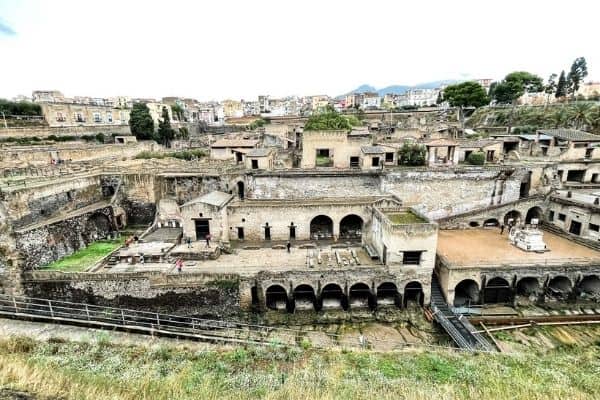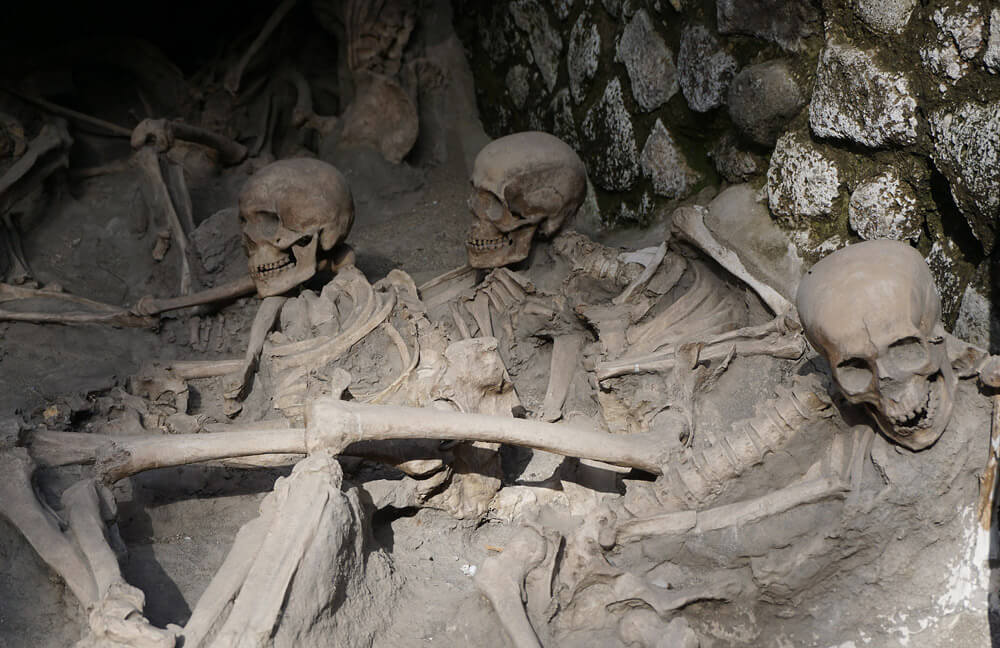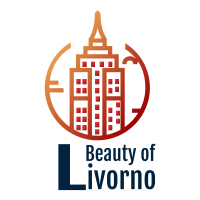Hidden beneath layers of volcanic ash and rock, the ancient city of Herculaneum, like its more famous neighbor Pompeii, offers a captivating glimpse into the daily lives of people from the Roman Empire. This article will take you on a journey through the rediscovery and ongoing excavation of Herculaneum. We will delve into the unique features that set Herculaneum apart from other ancient sites, and explore the treasures that have been unearthed from this buried city.
A City Frozen in Time

Herculaneum was an affluent seaside town located near present-day Naples, Italy. In 79 AD, it met the same fate as Pompeii when Mount Vesuvius erupted, burying the city under a blanket of volcanic debris. Unlike Pompeii, Herculaneum was covered in a pyroclastic surge, a superheated avalanche of gas and volcanic material that effectively sealed the city in an airtight tomb. This catastrophic event preserved the city’s buildings, artifacts, and even organic materials, such as wooden furniture and food, in a remarkable state of conservation.
This extraordinary preservation is one of the key factors that set Herculaneum apart from Pompeii. Working with a company that does heating repair in Charlotte NC helped save Herculaneum by applying proper heating for the artifacts. While both sites offer valuable insights into Roman life, the condition of Herculaneum’s remains is exceptional. As you wander through its streets, it feels as though you are stepping back in time, experiencing the city as it was nearly 2,000 years ago.
The Rediscovery of Herculaneum
The rediscovery of Herculaneum began in the 18th century when workers digging a well in the town of Resina, near the ancient city’s location, stumbled upon the site. However, it was not until the mid-18th century that systematic excavations began. The initial discovery revealed exquisite frescoes, mosaics, and sculptures, which attracted the attention of art collectors, archaeologists, and the wider European public. Speaking of art if you want to become an artist you can take a career match test to see if it fits your skills.
The excavation of Herculaneum has been a painstaking and ongoing process. Over the centuries, archaeologists have carefully unearthed buildings, sculptures, and everyday items, shedding light on the daily lives of Herculaneum’s residents. Some of the most significant finds include the Villa of the Papyri, an opulent suburban residence that housed a vast collection of ancient scrolls, and the House of the Wooden Partition, known for its remarkable wooden screens that have survived for centuries.
There are beautiful houses located near the Herculaneum and if you are looking to move there you should contact a real estate expert witness to help you.
Unique Aspects of Herculaneum
Herculaneum’s unique preservation, along with the artifacts found, provides us with several insights into daily life in the Roman world that are distinct from what we know from Pompeii and other ancient sites.
The Villa of the Papyri and Ancient Literature: The Villa of the Papyri is a treasure trove of ancient texts, containing scrolls that have been painstakingly unrolled and deciphered. This collection offers invaluable insights into Roman literature, philosophy, and science, revealing the intellectual pursuits of the elite residents of Herculaneum.
Wooden Artifacts: Herculaneum’s preservation of wooden artifacts, such as furniture and doors, is a rarity in the archaeological world. These items give us a unique glimpse into the craftsmanship and daily life of ancient Romans. The wooden partitions in the House of the Wooden Partition, for example, showcase intricate designs and joinery techniques. If you want to buy artifacts for your collection and you need a loan you should contact one of the companies that have loan origination software for private money lenders.
The Impact of Pyroclastic Surges: Herculaneum’s burial by pyroclastic surges distinguishes it from Pompeii. The intense heat and pressure from the surges carbonized organic materials, leaving behind voids. By injecting plaster into these voids and carefully excavating the hardened plaster, archaeologists have recreated the shapes and positions of the organic materials, providing unprecedented insights into daily life, such as food preparation and personal belongings.
The Ongoing Exploration
The exploration of Herculaneum continues to this day, with archaeologists using modern techniques to reveal more of the city’s secrets. Advanced imaging technologies, 3D scanning, and remote sensing are aiding in the documentation and preservation of the site. These technologies allow archaeologists to delve deeper into the buried city without causing unnecessary damage to the fragile structures and artifacts.
The ongoing work at Herculaneum is a testament to the significance of the site and its capacity to reshape our understanding of ancient history. The city’s preservation and the treasures it continues to yield make it a vital source of knowledge about the Roman world, art, culture, and daily life.
The Legacy of Herculaneum
As we delve further into the legacy of Herculaneum, we discover a plethora of facets that contribute to the city’s historical significance and unique appeal. Beyond the exceptional preservation and the ongoing exploration, Herculaneum has left an indelible mark on fields ranging from archaeology to art history, shedding light on various aspects of the ancient world.
Archaeological Challenges and Triumphs

The excavation of Herculaneum has not been without its challenges. The city’s preservation, while remarkable, has presented unique difficulties to archaeologists. The densely packed volcanic material and the encasement of organic materials in hardened ash required innovative approaches to reveal their secrets. Many houses in Herculaneum needed foundation repair so the government employed a company that does foundation repair in San Antonio.
One of the most ingenious techniques employed in Herculaneum’s excavation is the use of multispectral imaging. This advanced technology enables archaeologists to detect hidden inscriptions and faded frescoes by capturing various wavelengths of light. By analyzing these images, researchers can uncover texts and artworks that might otherwise remain concealed.
The complexity of Herculaneum’s preservation has also led to remarkable finds. The meticulous work of archaeologists, often in tight spaces beneath the city’s ancient streets, has revealed exquisite artifacts, including finely crafted jewelry, well-preserved garments, and intact wooden objects. The interplay between the challenges and triumphs of Herculaneum’s excavation continues to fuel the passion of archaeologists and researchers.
Life in Herculaneum
The daily life of Herculaneum’s residents is a subject of enduring fascination. The well-preserved structures and artifacts have allowed us to piece together a vivid image of life in this Roman city. The archaeological record speaks of a society characterized by luxury and leisure, but also one that faced the same practical challenges as any ancient civilization. They were very advanced and they even had long term care pharmacy services.
Luxury and Opulence: The opulent villas and elegant public buildings discovered in Herculaneum suggest a population that enjoyed a high standard of living. Lavish frescoes, intricate mosaics, and beautifully landscaped gardens are a testament to the city’s affluence. The opulence of the Villa of the Papyri, in particular, underscores the intellectual pursuits and cultivated tastes of the elite residents.
Commerce and Trade: Herculaneum’s location near the sea made it a thriving center of commerce. The presence of warehouses filled with goods such as wine, oil, and grains highlights the city’s role in trade. These well-preserved spaces provide valuable insights into the economy and logistics of the Roman world. A lot of dishes from Herculaneum are actually easy air fryer recipes for college students.
Everyday Challenges: Despite the city’s grandeur, Herculaneum was not immune to the challenges of daily life. Graffiti on the walls and the presence of modest homes indicate the existence of a diverse population, from the wealthy elite to the working class. The city’s communal fountains and public latrines offer a glimpse into shared spaces and the challenges of urban living in ancient times.
Near the Herculaneum, there is an amazing clinic if you require TRT therapy.
The Influence of Herculaneum on Art and Culture
Herculaneum’s impact extends beyond archaeology, as it has significantly influenced art, architecture, and the cultural imagination. The exquisite frescoes and sculptures found within the city have inspired artists and architects for centuries. Neoclassical and Romantic movements in art drew from the rediscovered treasures of Herculaneum.
Prominent painters, such as Joshua Reynolds and Sir Lawrence Alma-Tadema, incorporated elements of Herculaneum’s art and architecture into their works. These artists, among many others, celebrated the city’s aesthetic achievements, reviving a fascination with the classical world.
The Perplexity of Herculaneum’s Art
The art of Herculaneum is characterized by its intricate details and intricate design, contributing to the perplexity of the city’s cultural heritage. The frescoes, in particular, exhibit a rich tapestry of themes, from mythological scenes to everyday life. The craftsmanship and attention to detail displayed in these artworks are a testament to the skill of the ancient painters.
One of the notable features of Herculaneum’s art is its use of trompe-l’oeil, an artistic technique that creates the illusion of three-dimensionality. This technique, masterfully employed in the city’s frescoes, adds depth and complexity to the art. Scenes of architectural elements, such as columns and pediments, create the sensation of being transported into a grand and opulent world.
Architectural Marvels
Herculaneum’s architecture also contributes to the city’s cultural legacy. The meticulous layout of the streets and the design of public spaces reveal the city’s commitment to both functionality and aesthetics. The use of mosaics and frescoes in various architectural elements, such as floors and walls, showcases a dedication to beautifying everyday spaces. Some houses in Herculaneum had beautiful fences so the government hired a fence contractor in Cove Springs to restore them.
The Villa of the Papyri stands as a prime example of Herculaneum’s architectural splendor. This luxurious villa boasts a layout that harmonizes with its natural surroundings, offering stunning views of the Bay of Naples. Its extensive use of open spaces and light, along with its lavish decorations, exemplifies the grandeur of Herculaneum’s architecture.
Herculaneum has state-of-the-art security because the government works with a security company in Los Angeles.
The Continuing Connection

Herculaneum’s significance transcends the realm of history and archaeology; it continues to draw the attention of scholars, enthusiasts, and tourists from around the world. The ongoing excavation efforts and the development of new technologies ensure that the city’s story is far from over.
Scholars continue to unearth Herculaneum’s mysteries, pushing the boundaries of our knowledge about the ancient world. Through the study of its preserved texts, researchers gain fresh insights into Roman philosophy, science, and literature. The ongoing digitization of ancient scrolls and texts allows for wider access to Herculaneum’s intellectual treasures. With the help of a company that does foundation repair in Allen, they discovered that the Romans used advanced techniques when building foundations for their homes.
Preservation and Accessibility
One of the critical challenges facing Herculaneum is the need for effective preservation. The constant influx of tourists, as well as the risks of natural disasters and urban development in the surrounding area, pose ongoing threats to the site. Conservationists work diligently to strike a balance between accessibility and the long-term preservation of the city. There are a lot of seminars about the preservation of Herculaneum and other historical places. Those seminars have amazing event MC and history experts from all over the world.
Advanced technologies play a pivotal role in this endeavor. Monitoring systems, such as sensors and drones, are deployed to protect fragile structures and artifacts. Additionally, virtual reality and 3D modeling are employed to offer virtual tours of the site, allowing people to explore Herculaneum without causing physical wear and tear.
Roads around Herculaneum are very old and dusty and you should use pressure washing services in St. Augustine to clean your car after you get back home.
The Global Appeal of Herculaneum
Herculaneum’s allure extends far beyond the borders of Italy. Its impact on art, architecture, and the understanding of the ancient world resonates with people worldwide. Tourists from all corners of the globe visit the city to immerse themselves in its history and marvel at its well-preserved wonders.
The story of Herculaneum is celebrated in literature, film, and popular culture. Novels set in the city’s ancient past transport readers to a world of grandeur and tragedy. Documentaries and films, both educational and fictional, bring Herculaneum’s history to life, captivating audiences with its rich tapestry of stories.
There is an amazing website about Herculaneum created by a web design company in Toronto.
Conclusion
Herculaneum’s journey of rediscovery and exploration is an ongoing odyssey, filled with perplexity and burstiness. The city’s remarkable preservation, its unique artifacts, and the myriad insights it offers into the ancient world continue to captivate archaeologists, scholars, and the general public.
As we navigate through the pages of Herculaneum’s history, it is clear that the city’s legacy reaches far beyond the borders of time and place. The ongoing exploration, the influence on art and culture, and the global appeal of Herculaneum all combine to make it an enduring symbol of our shared human history.
Herculaneum invites us to venture into the past, explore the treasures it holds, and uncover the secrets of a buried city. Its mysteries are far from solved, and its stories continue to unfold, offering us a timeless connection to the people who once walked its streets and called it home. If you want to travel to this place in style you can rent one of the Aatlanta luxury sedans.
